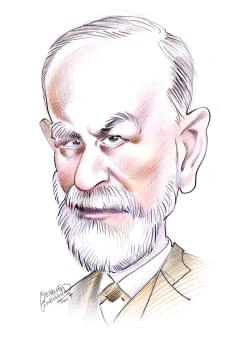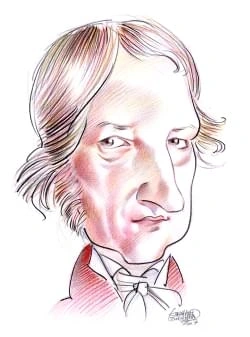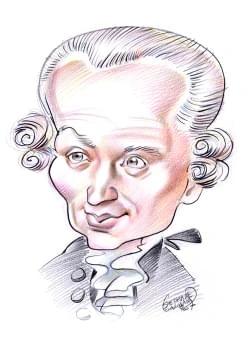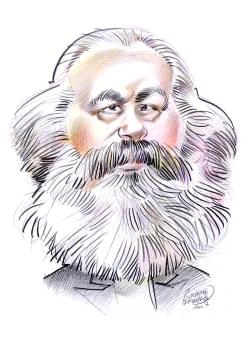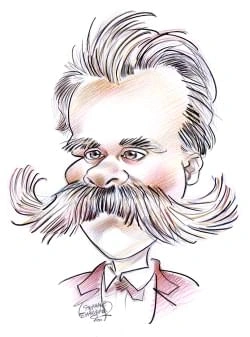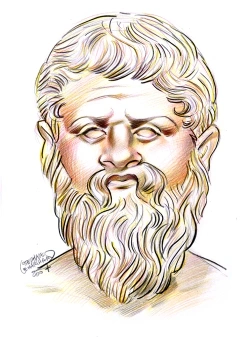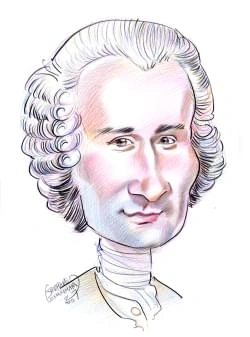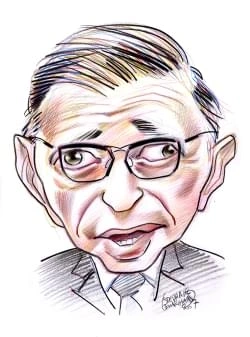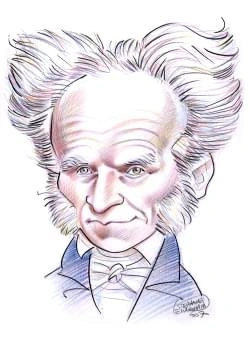141 résultats pour "sensée"
-
Est-il sensé de chercher un sens à tout ?
Sens et bon sens ne doivent pas être dissociésSeul l'insensé s'arrête à l'apparence des choses. L'homme de bon sens cherche à comprendre et cherche lesens. Il n'y a pas de honte à ignorer le sens des choses, mais on n'a pas le droit de renoncer à donner dusens à ce qui est. Il faut toujours chercher à rendre clair ce qui est obscur, à rendre cohérent ce qui estconfus.Le « bon sens » est synonyme de « raison », cela veut dire que «la raison est naturellement égale en touthomme », que chacun possè...
-
Est-il raisonnable de combattre toute illusion ?
La réalité n'est pas la seule norme. BIBLIOGRAPHIE Descartes, Méditations métaphysiques, éditions de poche diverses (Garnier-Flammarion, par exemple), PremièreMéditation.Freud, L'avenir d'une illusion, PUF.Nietzsche, La naissance de la tragédie, NRF, Gallimard. Introduction • Est-il raisonnable de combattre toute illusion ? Voici un intitulé qui nous questionne sur un choix fréquent dans laquotidienneté, sur une certaine manière d'être au monde et d'appréhender ce dernier. Remarquons que...
-
Est-il sensé d'expliquer le réel ?
immanquablement, ne peut proposer qu'une explication limitée (par la simple limite de son point de vue et de saréflexion personnelle) d'une totalité. Ainsi la philosophie préfère parler de « réalité », rappelant par ce mot, qu'il nes'agit là que de l'appréhension limitée d'un esprit sur un réel qui l'englobe (l'inverse étant donc impossible). II) Le sens d'une recherche de sens Mais force est de constater que malgré cette limite absolue fixée à toute tentative d'explication du réel, rien nese...
-
Fascism.
values as coming before a radical political transformation. Others argue that a radical political transformation will then be followed by a change in values. Fascists claimthat the nation has entered a dangerous age of mediocrity, weakness, and decline. They are convinced that through their timely action they can save the nation fromitself. Fascists may assert the need to take drastic action against a nation's 'inner' enemies. Fascists promise that with their help the national crisis will end an...
-
Plato
I
INTRODUCTION
Plato (428?
one of the individuals escapes from the cave into the light of day. With the aid of the sun, that person sees for the first time the real world and returns to the cave withthe message that the only things they have seen heretofore are shadows and appearances and that the real world awaits them if they are willing to struggle free oftheir bonds. The shadowy environment of the cave symbolizes for Plato the physical world of appearances. Escape into the sun-filled setting outside the cave symbolize...
-
Plato.
one of the individuals escapes from the cave into the light of day. With the aid of the sun, that person sees for the first time the real world and returns to the cave withthe message that the only things they have seen heretofore are shadows and appearances and that the real world awaits them if they are willing to struggle free oftheir bonds. The shadowy environment of the cave symbolizes for Plato the physical world of appearances. Escape into the sun-filled setting outside the cave symbolize...
-
Brain.
The hypothalamus lies beneath the thalamus on the midline at the base of the brain. It regulates or is involved directly in the control of many of the body's vital drivesand activities, such as eating, drinking, temperature regulation, sleep, emotional behavior, and sexual activity. It also controls the function of internal body organs bymeans of the autonomic nervous system, interacts closely with the pituitary gland, and helps coordinate activities of the brain stem. D Brain Stem The brain st...
-
Anthropology.
humans, such as tools, pottery, and buildings) and human fossils (preserved bones). They also examine past environments to understand how natural forces, such as climate and available food, shaped the development of human culture. Some archaeologists study cultures that existed before the development of writing, a time knownas prehistory . The archaeological study of periods of human evolution up to the first development of agriculture, about 10,000 years ago, is also called paleoanthropology....
-
-
Coleridge's poem: Frost at midnight
– the singing redbreast suggests springtime while his hue transfers by implication to the apples on the tree to figure the ripeness of autumn. – The frost remembers the winter season > Appreciation of Nature "This populous village !" (l.11) exclamation = admiration, enthusiasm Third verse paragraph : a real ode to nature = sort of a lyricism veil upon that part of the text - 55-60 => natural elements "mountains, clouds,lakes, shores" = accumulatio...
-
Encyclopedia of Philosophy: The Theaetetus and the Sophist of Plato
channels through which we see colours and hear sounds. The objects of one sense cannot be perceived withanother: we cannot hear colours or see sounds. But in that case, the thought that a sound and a colour are notthe same as each other, but two different things, cannot be the product of either sight or hearing. Theaetetus hasto concede that there are no organs for perceiving sameness and difference or unity and multiplicity; the mind itselfcontemplates the common terms which apply to eve...
-
To have a conscience involves being conscious of the moral quality
ends up doing the right thing. Talk of a ‘perverted' conscience may mean that a person's ultimate convictions are judged to be perverse, as in the first strand identified; or that their capacity to know good from evil, in general or in the particular case, has been distorted or corrupted. Building on the above, we may note a third emphasis in the idea of conscience, to do with the care, intensity and frequency with which someone examines the moral credentials of their desires, feelings,...
-
From A Vindication of the Rights of Woman - anthology.
Ignorance is a frail base for virtue! Yet, that it is the condition for which woman was organized, has been insisted upon by the writers who have most vehementlyargued in favour of the superiority of man; a superiority not in degree, but essence; though, to soften the argument, they have laboured to prove, with chivalrousgenerosity, that the sexes ought not to be compared; man was made to reason, woman to feel: and that together, flesh and spirit, they make the most perfect whole, byblending hap...
-
Confucius
official to several of the highest positions in the land. Nor does the story end there. By the time of the Han dynasty (206 BC-AD 220), Confucius was celebrated as the ‘uncrowned king' of the state of Lu, and by the fourth century AD, any prefecture wanting to define itself as a political entity was required by imperial decree to erect a temple to Confucius. Gods in China are local cultural heroes who are remembered by history as having contributed meaning and value to the tradition, and of...
-
From "Resistance to Civil Government" - anthology.
intending it, as God. A very few—as heroes, patriots, martyrs, reformers in the great sense, and men—serve the state with their consciences also, and so necessarily resist it for the most part; and they are commonly treated as enemies by it. A wise man will only be useful as a man, and will not submit to be “clay,” and “stop a holeto keep the wind away,” but leave that office to his dust at least: “I am too high born to be propertied,To be a second at control,Or useful serving-man and instr...
-
Baroque Art and ArchitectureIINTRODUCTIONGerman Baroque ArchitectureThe baroque style of architecture flourished in Germany in the 18th century.
C Early baroque styles Conversion of Saint PaulItalian baroque painter Caravaggio painted scenes of realism and drama, often selecting lofty, religious themes anddepicting them with lower-class characters and settings with dramatic spotlighting. With its unidealized characters andfocus on the horse’s body, his Conversion of Saint Paul seems to record a stable accident, not a miraculous conversion byGod. This work was painted in 1601 and is in the Cerasi Chapel, Santa Maria del Popolo, Rome, It...
-
Excerpt from Barnaby Rudge - anthology.
Mr. Dennis rolled lazily over upon his breast, and resting his chin upon his hand in imitation of the attitude in which Hugh lay, said, as he too looked towards thedoor: “ Ay, ay, you knew him, brother, you knew him. But who'd suppose to look at that chap now, that he could be the man he is! Isn't it a thousand cruel pities, brother,that instead of taking his nat'ral rest and qualifying himself for further exertions in this here honourable cause, he should be playing at soldiers like a boy?...
-
-
Butterflies and Moths - biology.
The smallest butterflies are certain blues that have wingspans of a mere 0.7 cm (0.25 in). The largest are the female giant birdwings of Papua New Guinea, whichmeasure up to 30 cm (12 in) across. Moths range in size from tiny Microlepidoptera, several groups of small moths with wings no more than 0.16 cm (0.06 in) across, togiant silk moths, such as the atlas moth, which may exceed 30 cm (12 in) in wingspan. IV REPRODUCTION AND LIFE CYCLE Butterflies locate potential mates by sight, identifyin...
-
Encyclopedia of Philosophy: Abstract objects
to be an abstract object; but while it is not located anywhere, it has not always existed, but was devised at acertain time. Other examples are natural languages, many if not all works of art, and words and letters in the type-as opposed to token-sense (roughly, the sense in which there are just six, not eight, distinct letters in the word'abstract') (see Type/token distinction ). Thus while the abstract-concrete distinction undoubtedly has much to do with spatiality and temporality, it does no...
-
Ludwig van Beethoven
I
INTRODUCTION
Ludwig van Beethoven (1770-1827), German composer, considered one of the greatest musicians of all time.
dedication after learning that Napoleon had taken the title of emperor. Beethoven’s other instrumental works from the period of the Eroica also tend to expand the formal framework that he inherited from Haydn and Mozart. The Piano Sonata in C major op. 53 ( Waldstein ) and the Piano Sonata in F minor op. 57 ( Appassionata ), completed in 1804 and 1805 respectively, each employ bold contrasts in harmony, and they use a broadened formal plan, in which the meditative slow movements flow directly...
-
Ludwig van Beethoven.
dedication after learning that Napoleon had taken the title of emperor. Beethoven’s other instrumental works from the period of the Eroica also tend to expand the formal framework that he inherited from Haydn and Mozart. The Piano Sonata in C major op. 53 ( Waldstein ) and the Piano Sonata in F minor op. 57 ( Appassionata ), completed in 1804 and 1805 respectively, each employ bold contrasts in harmony, and they use a broadened formal plan, in which the meditative slow movements flow directly...
-
Ludwig van Beethoven
I
INTRODUCTION
Ludwig van Beethoven
Ludwig van Beethoven is considered possibly the greatest Western composer of all time.
the other hand, breaks up the opening theme into contrasting segments in different tempi, whereas customary practice called for stating the theme in its entirety at thebeginning of a movement. In the first movement of the Eroica Symphony, one of the major works from Beethoven’s middle period, he again sought ways to expand upon the prevailing musical forms. At that time, composers usually organized movements in three major parts. First, the exposition introduces the musical themes of the pie...
-
Excerpt from The Tempest - anthology.
When he comes back; you demi-puppets thatBy moonshine do the green, sour ringlets make,Whereof the ewe not bites; and you whose pastimeIs to make midnight mushrumps, that rejoiceTo hear the solemn curfew, by whose aid—Weak masters though ye be—I have bedimmedThe noontide sun, called forth the mutinous winds,And 'twixt the green sea and the azured vaultSet roaring war; to the dread rattling thunderHave I given fire, and rifted Jove's stout oakWith his own bolt; the strong-based promontoryHave I m...
-
ÉTRANGER — GROUPE 1, SESSION DE JUIN 1995 LANGUE VIVANTE 2 - SÉRIE L
Mary Marshall had been related to bis sister' s husband' s family - but other than that, be didn't know much about ber. "I believe 30 she made a living of sorts selling herbs." Zoe described the state of the place. "ln time, when Lowell bas improved it, it will be sold. But not for very much. lt's the long term prospect of bis unemployment that worries me. lt isn't good for bim emotionally. And, of course, we need the money". In case...
-
Sir Christopher Wren
I
INTRODUCTION
Sir Christopher Wren (1632-1723), English architect, scientist, and mathematician, who is considered his country's foremost architect.
Saint Paul’s Cathedral, LondonSaint Paul’s Cathedral, a major London landmark and the greatest achievement of architect Sir Christopher Wren, is a fineexample of English Baroque architecture. It was completed in 1710 and replaced the older cathedral that had beendestroyed in the Great Fire of 1666.Courtesy of Liesel Stanbridge Wren's designs for St. Paul's Cathedral were accepted in 1675, and he superintended the building of the vast baroque structure until its completion in 1710. It ranks asone...
-
-
Word & Image
A Journal of Verbal/Visual Enquiry
ISSN: 0266-6286 (Print) 1943-2178 (Online) Journal homepage: https://www.
Reception and interference: reading Jean Molinet's rebus-poems ADRIAN ARMSTRONG Northern French culture in the late Middle Ages is marked not only by a proliferation of visual images, but also by the knowledge which these images convey, velY often in the form of figurative discourse. Traditional coded or symbolic visual fornls include heraldly, where tinctures and charges often accumulate particular connotations, and typological staine...
-
baudelaire analyse L'ennemi
Baudelaire highlighting the time that passes through a progression from the past to the present, the discouraging record of this stormy youth is underlined by the past composed «on fait» (vers 3) and by the proposition of consequence to the present. The metaphor continues in the mention of a nature which has undergone the meteorological elements in their destructive character, the past having left traces: a life ravaged by «le tonnerre et la pluie», by the blows of fate and the daily g...
-
From The Sound and the Fury - anthology.
'You'd better slip on your pants and run,' he said. He went out. I got up and moved about, listening to him through the wall. He entered the sitting-room, toward the door. 'Aren't you ready yet?' 'Not yet. Run along. I'll make it.' He went out. The door closed. His feet went down the corridor. Then I could hear the watch again. I quit moving around and went to the window and drew thecurtains aside and watched them running for chapel, the same ones fighting the same heaving coat-s...
-
Conceptual analysis
Kant's important idea that conceptual truths can be either analytic a priori or synthetic a priori is effectively erased by Gottlob Frege in his Foundations of Arithmetic (1884). Frege's overriding philosophical aim is to put mathematical proof on a firm footing by reducing the truths of arithmetic to analytic truths of logic. In view of this, the proper goal of an analysis is the production of non-circular, explanatory, yet meaning-preserving general definitions of fundamental concepts -...
-
Suicide.
C Sociological Theories Most social scientists believe that a society’s structure and values can influence suicide rates. French sociologist Émile Durkheim argued that suicide rates are related tosocial integration —that is, the degree to which an individual feels part of a larger group. Durkheim found suicide was more likely when a person lacked social bonds or had relationships disrupted through a sudden change in status, such as unemployment. As one example of the significance of social bond...
-
Herman Melville
I
INTRODUCTION
Herman Melville
These lines (recited by an actor) begin the novel Moby Dick (1851), by Herman Melville.
short novel Billy Budd in manuscript form. Melville’s death in New York City on September 28, 1891, went virtually unnoticed. None of his books was still in print. VI MELVILLE’S EARLY WORKS With the exception of Mardi , all of Melville’s early books are narratives of maritime adventure based upon his own experiences and on his wide reading. Although London publisher John Murray accepted Typee for his Home and Colonial Library as a strictly factual account of South Seas travel, he was lar...
-
Acting
I
INTRODUCTION
Lee Strasberg
American acting teacher Lee Strasberg was best known for his association with the Actors Studio, of which he became the
artistic director in 1951.
truthfully felt those emotions at the moment they expressed them. Finding the true feeling in the proper place and time on stage, however, was a problem that Aristotleaddressed less well. He concluded that acting was an occupation for the gifted or insane. How to cross the artistic boundary beyond feigned emotions and flat imitation obsessed many Greek actors. In 315 BC the tragedian Polus carried the real ashes of his recently deceased son in an urn to stimulate a sense of genuine grief when h...
-
Herman Melville.
information in Omoo , but various religious groups condemned both books for their unfavorable comments on the work and insensitivity of missionaries in the South Seas. Mardi is a philosophical allegory framed by another adventure at sea. The book’s hero, accompanied by characters representing the intellect, poetry, history, and philosophy, searches the world for universal truth. The book is filled with descriptions—intended as allegories—of human customs, religions, governments, and historical...
-
-
Michelangelo
I
INTRODUCTION
Michelangelo (1475-1564), Italian painter, sculptor, architect, and poet whose artistic accomplishments exerted a tremendous influence on his contemporaries and on
subsequent European art.
(17 ft) tall, was carved from a block of stone that another sculptor had left unfinished. Michelangelo drew on the classical tradition in depicting David as a nude,standing with his weight on one leg, the other leg at rest ( see contrapposto). This pose suggests impending movement, and the entire sculpture shows tense waiting, as David sizes up his enemy and considers his course of action. While David reveals Michelangelo's expert knowledge of anatomy (he had been dissecting corpses for about...
-
Michelangelo.
(17 ft) tall, was carved from a block of stone that another sculptor had left unfinished. Michelangelo drew on the classical tradition in depicting David as a nude,standing with his weight on one leg, the other leg at rest ( see contrapposto). This pose suggests impending movement, and the entire sculpture shows tense waiting, as David sizes up his enemy and considers his course of action. While David reveals Michelangelo's expert knowledge of anatomy (he had been dissecting corpses for about...
-
Turtle.
Turtles use their jaws to cut and handle food. Instead of teeth, a turtle’s upper and lower jaws are covered by horny ridges, similar to a bird’s beak. Meat-eating turtlescommonly have knife-sharp ridges for slicing through their prey. Plant-eating turtles often have ridges with serrated edges that help them cut through tough plants.Turtles use their tongues in swallowing food, but unlike many other reptiles, such as chameleons, they cannot stick out their tongues to capture food. C Limb Structu...
-
Turtle - biology.
Turtles use their jaws to cut and handle food. Instead of teeth, a turtle’s upper and lower jaws are covered by horny ridges, similar to a bird’s beak. Meat-eating turtlescommonly have knife-sharp ridges for slicing through their prey. Plant-eating turtles often have ridges with serrated edges that help them cut through tough plants.Turtles use their tongues in swallowing food, but unlike many other reptiles, such as chameleons, they cannot stick out their tongues to capture food. C Limb Structu...
-
Elephant - biology.
B Trunk An elephant's nose and upper lip are combined in a long, limber trunk, an exceptionally supple appendage with an estimated 150,000 muscles. The versatile trunk actslike a hand for grasping low-growing shrubs and other food and placing it into the mouth; an arm for breaking off tree branches; or a snorkel for breathing when theelephant's body is submerged. Elephants also use their trunks to suck up water and squirt it into their mouths for drinking or over their bodies for bathing. Nostr...
-
Amphibian (animal) - biology.
strong enough to kill potential predators. C Hearing, Vision, and Vocalizations Amphibians rely on their senses to find food and evade predators. Amphibians lack external ears but have well-developed internal ears. Hearing is most acute in frogs,which typically have a middle ear cavity for transferring sound vibrations from the eardrum, or tympanum, to the inner ear. Frogs and toads also use their keen hearingin communicating with one another. Using a true voice box, or larynx, and a large, exp...
-
Portraiture
I
INTRODUCTION
Portraiture, visual representation of individual people, distinguished by references to the subject's character, social position, wealth, or profession.
CaracallaCaracalla is a Roman portrait bust in marble of the emperor Marcus Aurelius Antoninus, probably done circa ad 215. Theson of Septimius Severus, Caracalla (as he was known) was a brutal man whose qualities come through in this piece withits dramatic realism. The bust, which is now in the Louvre, Paris, evidently served as the inspiration for Michelangelo’sbust of Brutus more than one thousand years later.Bridgeman Art Library, London/New York The first representations of identifiable ind...
-
Literary Criticism
I
INTRODUCTION
Literary Criticism, discussion of literature, including description, analysis, interpretation, and evaluation of literary works.
IV THE 17TH AND 18TH CENTURIES The climate of criticism changed with the arrival on the literary scene of such giants as Miguel de Cervantes, Lope de Vega, and Pedro Calderòn in Spain; WilliamShakespeare, Ben Jonson, and John Milton in England; and Pierre Corneille, Jean Baptiste Racine, and Molière in France. Most of these writers specialized or excelled indrama, and consequently the so-called battle of the ancients and moderns—the critical comparison of Greek and Roman authors with more rece...
-
-
Anatomy.
The body defends itself against foreign proteins and infectious microorganisms by means of a complex dual system that depends on recognizing a portion of the surfacepattern of the invader. The two parts of the system are termed cellular immunity, in which lymphocytes are the effective agent, and humoral immunity, based on theaction of antibody molecules. When particular lymphocytes recognize a foreign molecular pattern (termed an antigen), they release antibodies in great numbers; other lymphocy...
-
Animal Behavior - biology.
The first motor program analyzed in much detail was the egg-rolling response of geese. When a goose sees an egg outside its nest, it stares at the egg, stretches itsneck until its bill is just on the other side of the egg, and then gently rolls the egg back into the nest. At first glance this seems a thoughtful and intelligent piece ofbehavior, but it is a mechanical motor program; almost any smooth, rounded object (the sign stimulus) will release the response. Furthermore, removal of the egg on...
-
Renaissance Art and Architecture
I
INTRODUCTION
Renaissance Composition
During the Renaissance (15th and 16th centuries) artists discovered new ways to help them create more realistic and
compelling images.
with reliefs, had been familiar for centuries. A Early Renaissance Sculpture Ghiberti’s Gates of ParadiseThe Gates of Paradise are bronze doors created by Italian Renaissance sculptor Lorenzo Ghiberti between 1425 and 1452for the east entrance to the baptistery of the Florence Cathedral in Italy. This detail, showing Isaac and Esau, is from oneof the doors' ten panels, each of which illustrates a story from the Bible. Ghiberti endowed the scenes with volume, depth,and movement, and helped initi...
-
Spider (arthropod) - biology.
The spider’s abdomen is soft and saclike. On the underside of the tip of the abdomen are three pairs of spinnerets. Each spinneret is studded with many fine, hairliketubes called spigots, which produce a variety of silk threads. The spigots lead to several large silk glands inside the abdomen. Silk is formed as a liquid inside theseabdominal glands. As the silk is drawn out through the spigots, protein molecules within the silk line up parallel to one another, causing the silk to harden and form...
-
Ecuador - country.
F Natural Resources Ecuador’s main mineral wealth is in petroleum. Other mineral resources of the country include gold, silver, copper, lead, and zinc. Forests cover 38.3 percent of thecountry. G Plants and Animals Along the northern part of the Ecuador coast, and within the inner portion of the southern coast, tropical jungles abound. In some places the jungles extend up theslopes of the Andes as wet, mossy forests. Dense forests cover both flanks of the Cordilleras, as well as the Oriente, u...
-
Physics
I
INTRODUCTION
Physics, major science, dealing with the fundamental constituents of the universe, the forces they exert on one another, and the results produced by these forces.
Starting about 1665, at the age of 23, Newton enunciated the principles of mechanics, formulated the law of universal gravitation, separated white light into colors,proposed a theory for the propagation of light, and invented differential and integral calculus. Newton's contributions covered an enormous range of naturalphenomena: He was thus able to show that not only Kepler's laws of planetary motion but also Galileo's discoveries of falling bodies follow a combination of his ownsecond law of m...
-
Human Evolution.
Strepsirhines are the most primitive types of living primates. The last common ancestors of strepsirhines and other mammals—creatures similar to tree shrews andclassified as Plesiadapiformes—evolved at least 65 million years ago. The earliest primates evolved by about 55 million years ago, and fossil species similar to lemursevolved during the Eocene Epoch (about 55 million to 38 million years ago). Strepsirhines share all of the basic characteristics of primates, although their brains are notpa...
-
Human Evolution - biology.
classified as Plesiadapiformes—evolved at least 65 million years ago. The earliest primates evolved by about 55 million years ago, and fossil species similar to lemursevolved during the Eocene Epoch (about 55 million to 38 million years ago). Strepsirhines share all of the basic characteristics of primates, although their brains are notparticularly large or complex and they have a more elaborate and sensitive olfactory system (sense of smell) than do other primates. B Haplorhines B1 Tarsiers T...
-
- L'histoire est-elle sensée ?
-
Buffier, Claude
I possess something I call intelligence and something independent of this intelligence that I call my body; The presence of design, such as we find in a watch, requires an intelligent designer; The self or soul is absolutely one; I possess a free will. While Buffier does recognize certain differences between the claims of outer and inner experience, he refuses simply to place them on the same scale and declare the former to be weaker than the latter. Instead, he will say that both are equally '...
}})
